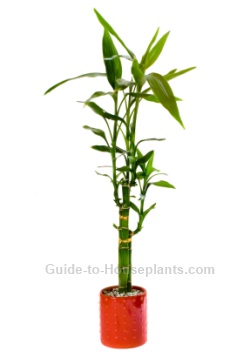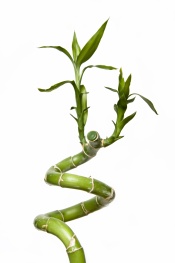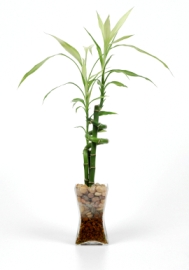





Botanical Name: Dracaena sanderiana

Lucky Bamboo first hit the garden centers in the late 1990s. Care for indoor bamboo plant couldn't be easier: it will grow in a vase of water with pebbles to keep it upright.
This striking bamboo plant has a slender, upright stem and graceful, arching green leaves that taper to a point.
Its roots are red -- so don't worry if you see red roots in the vase. This is normal for a healthy plant.
It's not really a bamboo. This member of the Dracaena family has been around a long time, but has become a favorite of feng shui enthusiasts because it is believed to enhance chi energy and bring good luck.
Dracaenas find homes in many offices and dorms because they can be ignored for days (or weeks!) without suffering from neglect.
Give your bamboo house plant bright light to help it look its best, but keep this plant out of direct sun to avoid burning its foliage.
It's a good idea to use an opaque vase. Sunlight coming through clear glass will encourage the growth of algae. If the water becomes murky, just clean the vase and pebbles and refill it with clear water.
Indoor bamboo problems are few. Yellow leaves are usually caused by too much sun or too much fertilizer. Cut back on fertilizer and move your bamboo plant to a shadier spot. Brown leaves indicate dry air or chemicals present in the water. (See watering tips below.) Stalks that turn soft and mushy are probably beyond saving. Remove them right away to avoid contaminating the other stalks. If you want to try to save them, you can cut off the mushy parts and place the trimmed stalks in fresh water.

Lucky bamboo pruning will keep your plant in good shape. Don't cut the main stalk -- just cut the offshoots within 1-2 in (2.5-5 cm) of the main stalk. This will cause new shoots to grow, creating a fuller, bushier plant. Don't throw those cuttings away, either -- root them in fresh water to start new plants.
Wondering how to make those twists and curves?
Although often compared to bonsai, this bamboo house plant is not shaped with wire and frequent trimming. Instead, it is shaped by rotating the plant's stalks. Turning a stalk slowly and regularly in front of a light source naturally causes the stalk to grow toward the light. This is a labor-intensive process and difficult to do in the home.

Origin: Africa
Height: Up to 3 ft (90 cm)
Light: Bright light, but no direct sun which will scorch leaves.
Water: Change the water every week or two. This plant is sensitive to chlorine, fluoride, and other chemicals often found in tap water. Use only distilled or bottled water, or allow tap water to sit overnight so the chemicals will evaporate.
Humidity: Average room humidity.
Temperature: Normal room temperatures. 60-75°F/16-24°C
Soil: N/A
Fertilizer: Feed every 2 months with an all-purpose liquid fertilizer. Just a drop will do.
Propagation: Take stem cuttings in summer and stand in fresh water.
Copyright © www.100flowers.win Botanic Garden All Rights Reserved